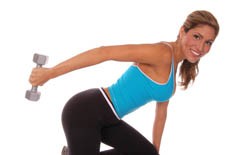Today was a great morning. Why? Because when I was at the gym for a couple of sessions the gym was hopping.And I don't mean the cardio side of the gym which is normally busy but the weight room side. This brings a smile to my face as it makes me feel the message is starting to get out there to the masses that intense resistance-based workouts is the way to go for weight loss, sports performance or general fitness. Period.While part of the crowd had to do with it being a Monday morning in January it was still encouraging to see a shift in training approaches taking place.So what about the rest of the people there? Why are there still so many cardio kings & queens? Well part of it is mis-information and believing that cardio will yield the best return on their investment. But part of it has to do with intimidation. Or not knowing what load to use.You see many people would rather go to the gym and feel productive by walking/running on the treadmill than to venture over to the weight room side and feel lost.So how can you feel confident and safe when selecting your weights for your training session? Here are 4 rules.Rule #1 On Selecting the Correct Weight - Consider the muscles doing the workIf the first thing you can answer is what part of the body you will be working or what movements you will be performing you will do a better job at choosing the correct weight. For examplen if you were performing a squatting exercise you will be able to handle a heavier load than an exercise for the triceps. Duh, right?You'd be surprised though to see the number of people that use the same dumbbell to squat with and then go straight into a...
For the Best Fitness Results You Need to Load to Unload
- Chris Collins
- Training
- 1804 Hits
- 12 Comments
-
Movement is an interesting thing. In some ways it comes naturally to us. Think of a baby on its back wiggling the arms and legs. Eventually with enough effort and momentum the baby will be able get a leg across the body, rotate the hips and flip onto their stomach.But what starts out as an inquisitive exploration of our surroundings can lead to many great abilities in sports and performance. As young kids we are fearless and will do and try just about anything to seek a thrill and have fun.As we get older life gets a little busier and we get a little wiser about the downside of being hell-bent for speed and thrills. Basically all we have to do is experience one injury to curb our thirst for extreme movement and velocity.But that doesn't have to mean sport and movement stops all together. In fact it can't and is essential for our vitality.So we must find that balance between fearlessly attacking a sport or activity with reckless abandom and taking ourselves 'out of the game' completely.And this balance comes with being able to load and unload the forces we experience with movement. And we do this most effectively when we have neuromuscular efficiency (NE). This basically means we get the right muscles to fire, at the right time and in the right plane.Unfortunately success in sport is not as simple as simply having NE because we still need to develop the fitness, strength and power of the relevant muscles. Add to that the demands for reading and reacting to an opponent as well as changing environmental conditions and you can quickly appreciate how skilled high level athletes really are.In order to develop some of the athletic abilities of the pros look to be able to efficiently load and unload the body....
